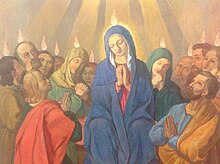Cenacle
Coenacle is a word with many different meanings. The word “ cenaculum ”, which comes from Latin, already has different meanings: dining room (often located on the upper floor), upper floor, attic, communion room. It is also occasionally used for Holy Communion itself.
Dining room, meeting or place of prayer
The word “cenacle” used in German was used by monasteries for the dining room (also refectory); religious groups also use this term in the sense of “prayer meetings” or for “spiritual meetings for a closed circle of participants” (e.g. family cenacle) , Priestly cenacle) or for a place of prayer or sending out into the world.
Upper Room in Jerusalem
The word cenacle or cenacle, on the other hand, in practice referred to the (historical) space of the Last Supper mentioned in the Bible, as well as the Pentecost event, i.e. the sending out by the Holy Spirit.
Cenacle with the Pallottines
Saint Vincenzo Pallotti had the meeting of the Jerusalem early community painted. The Pallottine Community understands the “cenacle” primarily to be the Upper Room and this in turn as a symbol that all Christians, all baptized men and women - with and without special consecrations - were sent out with the Spirit of God, that is, to follow Christ should, set out and be apostles. The Pallottines in Constance also use the Coenacle to refer to their “house of silence and contemplative prayer”, i.e. a place of assembly.
literature
- Brigitte M. Proksch : Participation - Diversity - Dialog. Vincent Pallotti's inspirations on ecclesiology. Pallotti Verlag, Friedberg 2014 ISBN 978-3-87614-000-1 , p. 180 ff.
- Pallotti Institute Vallendar : Maria, Queen of the Apostles (= Contributions to Pallottine Research (BpF), 3). Pallotti Verlag, Friedberg 2014, ISBN 978-3-87614-004-9 , p. 7f.
